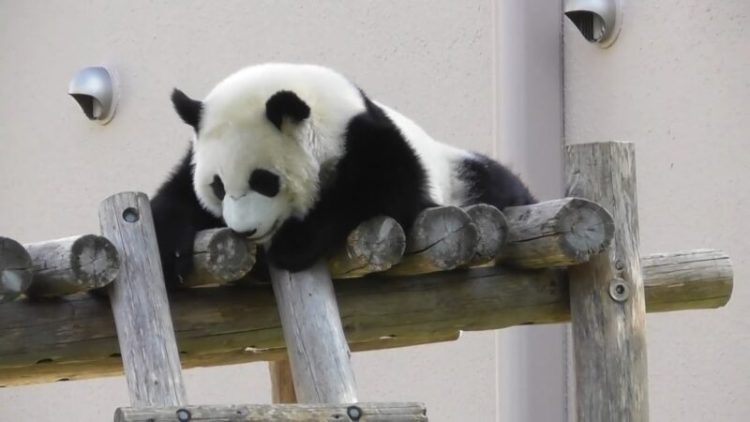“The Enigmatic Gathering: Unveiling the Charismatic Clan – A Group of Pandas”

In the heart of the dense bamboo forests of China, a captivating spectacle unfolds as nature’s charismatic ambassadors, the giant pandas, come together in a unique social structure known as a ‘group.’ While the term “group” might seem unremarkable, delving deeper into the dynamics of a panda gathering reveals a fascinating world of interconnected relationships, communal instincts, and the subtle nuances that define these enigmatic creatures.
Pandas: Solitary by Nature?
Giant pandas (Ailuropoda melanoleuca) are often associated with solitude, and this reputation is not entirely unfounded. In their natural habitat, these black and white bears are predominantly solitary animals. The rugged terrain of the mountainous regions, interspersed with dense bamboo thickets, shapes the panda’s lifestyle. The vast territories each panda claims are essential for accessing an ample supply of bamboo, the primary component of their diet.
However, the solitary nature of pandas does not preclude the existence of social interactions. In fact, pandas are known to congregate in groups for specific reasons, breaking the stereotype of their purely solitary existence.
The Communal Craving: The Panda Group
Contrary to the common perception of pandas as lone wanderers, they do form groups during certain periods of their lives. One of the most significant instances of panda gatherings is during the breeding season. The elusive nature of these bears during the rest of the year gives way to a more communal spirit when it comes to finding a mate.
Breeding Season: A Time for Connection
The mating season, usually occurring between March and May, triggers a unique transformation in the behavior of giant pandas. Male pandas, which are typically more solitary, embark on a quest to find a suitable mate. The scent markings left by females become the guiding beacon for males seeking companionship. This olfactory communication initiates the formation of what is often referred to as a ‘mating aggregation’ or ‘mating group.’
In these temporary gatherings, male pandas compete for the attention of receptive females. Playful interactions, vocalizations, and scent-marking rituals define the dynamics of these groups. While this communal display might seem short-lived, it plays a crucial role in ensuring the continuation of the panda population.
The Social Tapestry: Beyond Mating Groups
Apart from the mating season, pandas can also form groups under different circumstances. One such scenario is the congregation around plentiful food sources. Although bamboo constitutes the majority of their diet, pandas are known to supplement their nutrition with other plant materials, small mammals, or birds. When a particular area boasts an abundance of these alternative food sources, multiple pandas may gather, leading to a temporary social structure focused on mutual benefit.
Mother-Cub Bonds: A Special Kind of Panda Group
Perhaps one of the most heartwarming instances of panda groups is the relationship between a mother and her cubs. While adult pandas may prefer solitude, the early years of a cub’s life are marked by a strong bond with its mother. Female pandas give birth to relatively small and helpless cubs, and the early stages of cubhood require constant care and protection.
During the first few months, mother pandas devote their time to nurturing and raising their offspring. The mother-cub duo creates a tight-knit unit, with the mother providing nourishment, warmth, and guidance. This unique panda family is an essential aspect of the panda social structure, ensuring the survival and development of the next generation.
Conservation Challenges: Implications for Group Dynamics
The social dynamics of panda groups have implications for conservation efforts. As the giant panda continues to face threats such as habitat loss and fragmentation, climate change, and human activities, understanding their social behavior becomes crucial for devising effective conservation strategies.
Preserving large, interconnected habitats that support natural panda behaviors, including mating aggregations and mother-cub bonds, is vital for sustaining healthy panda populations. Conservation initiatives should not only focus on protecting individual pandas but also on preserving the intricate web of relationships that define their social structure.
Conclusion:
In the heart of the bamboo forests, where the misty mountains embrace the black and white fur of giant pandas, a fascinating story of social connections unfolds. While these bears are often depicted as solitary creatures, their lives are intricately woven into a tapestry of relationships, whether it be the temporary gatherings during the mating season, the communal sharing of abundant food sources, or the tender bonds between a mother and her cubs.
Understanding the dynamics of panda groups is not merely an academic pursuit but a key to unlocking the secrets of their survival. As conservation efforts continue to strive towards securing the future of these iconic bears, the enigmatic gatherings of pandas serve as a reminder that, even in the heart of solitude, connections and relationships play a pivotal role in the cycle of life for these charismatic creatures.
What is the term used to describe a group of pandas?
A: A group of pandas is commonly referred to as an “embarrassment” or “cupboard” of pandas. These whimsical terms add a touch of charm to the collective noun used for these iconic black and white bears.
Why is the term “embarrassment” used for a group of pandas?
A: The term “embarrassment” is a playful and somewhat archaic way to describe a group of pandas. It is not indicative of any embarrassing behavior on the part of the pandas themselves. Instead, it adds a lighthearted and unique flair to the language used to describe animal groups.
Are pandas typically solitary animals, or do they prefer to be in groups?
A: Pandas are primarily solitary animals. They tend to have large home ranges, and their solitary nature is especially pronounced outside of the breeding season. However, during specific periods, such as the breeding season, pandas may come together in temporary groups for mating purposes.
When do pandas form groups, and what happens during these gatherings?
A: Pandas typically form groups during the mating season, which generally occurs between March and May. Male pandas seek out receptive females by following scent markings. These gatherings, known as “mating aggregations” or “mating groups,” involve interactions, vocalizations, and scent-marking rituals as males compete for the attention of females.
Is there any other instance where pandas come together in groups?
A: Yes, pandas may also gather around abundant food sources. While they are primarily herbivores with bamboo constituting the majority of their diet, pandas are known to consume other plant materials, small mammals, or birds. In areas with a surplus of alternative food, multiple pandas may congregate, forming temporary social structures focused on shared resources.
What is the significance of the mother-cub bond in panda groups?
A: The mother-cub bond is a special and crucial aspect of panda social dynamics. Female pandas devote considerable time and care to raising their cubs, creating a close-knit family unit. This bond ensures the survival and development of the cubs during their early vulnerable months.
How does the social behavior of pandas impact conservation efforts?
A: Understanding the social behavior of pandas is essential for conservation efforts. Conservation initiatives need to consider the natural behaviors, such as mating aggregations and mother-cub bonds, to ensure the preservation of healthy panda populations. Protecting large, interconnected habitats that support these behaviors is vital for the long-term survival of these iconic bears.
Do pandas face any specific conservation challenges related to their social behavior?
A: Yes, habitat loss and fragmentation, climate change, and human activities pose significant threats to panda populations. Preserving the natural social behaviors of pandas requires safeguarding their habitats and addressing the broader environmental challenges that impact their ability to form temporary groups or maintain family units.
In summary, while pandas are primarily solitary creatures, they exhibit fascinating social behaviors during specific periods, and understanding these dynamics is crucial for both appreciating their natural behaviors and implementing effective conservation strategies.






